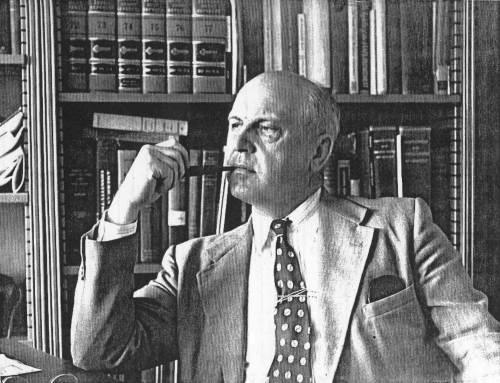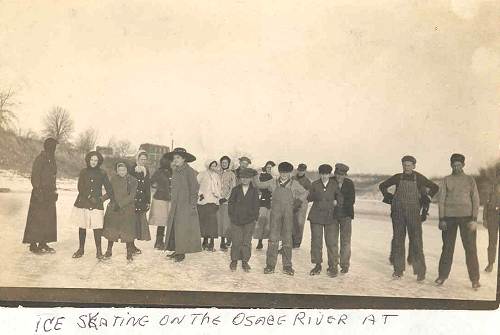|
Monday, December 24, 2007
Progress Notes
Out of town this week and under the weather as well I don't have much to submit this
week. I do have this interesting short narrative by Joseph Kallenbach, one of the many
Miller County students who went on to get higher degrees at various institutions around
the country. Joseph entered the department of Political Science at the University of
Michigan where he earned his post graduate degree and was a respected professor there for
many years (photo 01).

01 Joseph Kallenbach, PhD. - University of Michigan
Late in life he wrote a very detailed history of the memories of his life, titled "My
Life and Times", which very well details his childhood experiences in early
Tuscumbia as it was lived in the very early 1900s'. This book is remarkable in the
historical detail it records, especially since Joe left town in his late twenties or so.
It has not been published but was donated to our museum by the family:
Ice Skating on the Osage:
Joseph Ernest Kallenbach PhD. (1903-1991)
Department of Political Science
University of Michigan
Winter sports at Tuscumbia were, as a rule, no big thing, because
the climate there is too mild for pronged periods of ice and snow. Nevertheless, we could
count on having the opportunity to engage in skating and sledding to some extent during
the winter: Skating was possible whenever we had a very cold snap of several days
duration. It would cause ice to form on the quieter stretches of the Osage River.
Once in a while, the river would even become "blocked"
at some of its quieter stretches; that is, frozen solid from bank to bank. Usually only a
fringe area of relatively still water would have ice form on it slick enough for skating.
One such stretch of still water that would freeze was adjacent to the old steamboat
landing place near the center of the business section of town. At such times many of the
younger people would have a chance to try out their skates. One winter in January, 1916,
there was an unusual winter flood on the Osage. The flood was so great that it over flowed
the land along side the river's banks practically from hill to hill. At the very height of
the flood a very cold snap ensued, freezing a layer of ice several inches thick on the
flooded areas. When the water receded soon afterward, a coating of ice about four or five
inches thick was left lying on the more or less level ground where the over-flow water had
stood. This created an unusual opportunity for skaters. They found they could skate on
wide stretches of level land that was normally simply pasture land for horses and cattle (photo 02).

02 Ice Skating on Osage
Third from Left: Ella Fendorf Swanson
Sixth from Left: Rose James Fendorf, mother of Helen Fendorf Phillips
For a few days we had fun, skating there. We never had very good
skating equipment. No one, so far as I was aware, had skating boots or shoes, with skates
attached. The skates we all used were the clamp-on type. Skates could be attached to the
soles of ordinary shoes by pushing in clamps that would hold them in place. They were all
right for ordinary skating purposes; but there was always the problem of losing one's
skate when the clamps might give way. Moreover, our regular shoes did not give perfect
ankle support. We managed to get along pretty well, nevertheless, and learned to keep our
balance and move about quite rapidly. If the ice was thick enough, we would even build a
fire on the ice to provide warmth at intervals for our hands and feet.
Later one winter afternoon, I remember, I was skating alone on a
stretch of good ice at the steamboat landing just opposite the business part of town. I
had learned a few things about "fancy skating", and I was practicing the making
of a reverse figure eight by skating backward at fairly good speed. Suddenly my feet went
out from under me and I took a hard fall. I landed on the ice in such a way that my right
hand and wrist, as I fell backward, took most of the force of the fall. Naturally enough,
I looked around to see if anyone had seen me fall. I was relieved to see that no one
apparently had observed my tumble. But my right wrist hurt rather painfully. I decided I
had sprained it and thought little more about it. For weeks thereafter my right wrist was
sore and weak; but finally it appeared to have recovered and that was the end of it I
thought.
But that was not the end of it. Many years later, during the early
1950's, I was undergoing a thorough physical examination here at the University of
Michigan. The University administration had inaugurated a system of giving without charge
thorough physical examinations to Faculty members. When I went through this examination
routine the first time, I said to the examining physician, "Would you please take an
X-ray of my right shoulder and my left wrist?" I went on to explain that I had
suffered injuries to those place on my body when I went out for football at Central
Missouri State College many years earlier, and that they had continued to bother me some
ever since that time. The physician readily agreed, and the X-rays were taken. The
physician also had my right wrist X-rayed, for comparative purposes, he said.
When I went to receive my report on the examination, the physician
as he read through it, said, "You have a broken bone in your right wrist."
"No." I said, "Not my right wrist; it is the left
wrist which I hurt playing football that I wanted you to look at."
He looked at me and then began again, "You have a broken bone
in your right wrist."
I interrupted again, "Not my right wrist; my left
wrist."
He then said rather testily, "You have a broken bone in both
of your wrists." So I had to believe him. It was only the only time that, thinking
back, I concluded that my fall while ice skating had really resulted in a broken bone in
my right wrist. That remains my legacy from my adventures in ice skating! Fortunately it
does not bother me very much; but my broken bone in my left wrist has always been
something of a problem.
Thanks Joe.
I plan to quote frequently from Joe's historical narratives because in some cases he
remembers some things new to some of us around here.
I'll get in contact in a week or two…
| 


